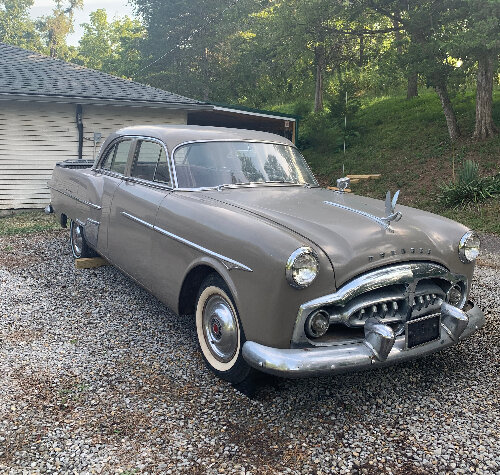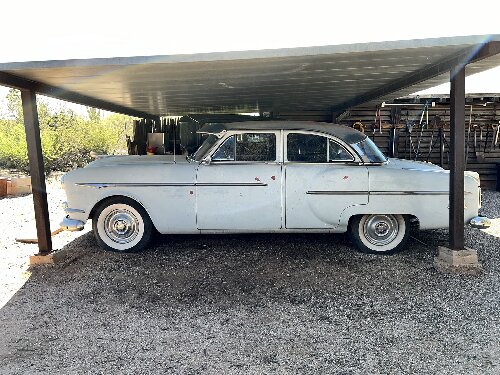|
Re: 1956 Packard 400 Wire Wheels
|
||||
|---|---|---|---|---|
|
Home away from home
|
Andrew M
My experience with these wires is not exactly in-line with Ross’s comment, but then again garages in Phoenix are not noted for their excessive humidity. I wash the wheels, off the car, about once a year when I do the whitewalls . . . otherwise they are wiped with a moist microfiber cloth. I have not waxed the wheels, but I suspect an annual coat would help in corrosion protection in other climates. I put a set of wires on both my ’54 and ’48, while I was buying new tires. The whole mess came from Coker, but before you point-out that’s not the same as Vintiques consider the following. Coker ships to Arizona from a California location. When you type the address of Vintiques into Google Maps the building is marked as Coker Tire. On Google Maps street view the building has many ‘Coker Tire’ signs, and ‘Coker Tire’ 18 wheelers outside, but nothing identifying ‘Vintiques’. By the way the name ‘Vintiques’ is not featured on the Coker website, but there is a statement that the wires are made in the USA . . . and the ‘Vintiques’ website states the wheels are made in City of Industry, CA. There is no claim as to the location where the chrome plating is done . . . my bet is 120 miles down the road. They do point-out that its triple chrome plating like there is a different, and lesser, process for chrome plating. All of those things taken together my bet is ‘Vintiques’ is a subsidiary of Coker . . . in fact the Wikipedia article about Coker Tire states that there are six companies in the Coker Group, but does not specifically state the six company names. I was told that the wheels are basically tubeless, but may need tubes after 5 years (leakage at the nipples). The ’54 wheels are 7 years old and have not begun that process as yet. I know from my chrome plated wire wheel experience on motorcycles the chrome flakes off the spokes in very short order. When stainless spokes became available the problem pretty much went away. The ‘Vintique’ wires have stainless spokes and nipples. If you need the diameter of the center hole I’ll measure it this weekend, but perhaps knowing the wheels fit a ’48 Deluxe, and a ’54 Cavalier the fitment on a ’56 could be inferred. dp
Posted on: 2021/4/13 18:50
|
|||
|
||||
|
Re: KPack's 1954 Panama
|
||||
|---|---|---|---|---|
|
Home away from home
|
Kevin;
If I remember correctly there were two designs in the routing of brake lines for dual master cylinders. One is the fore/aft plumbing, and the other is diagonal. I believe they were considered equally acceptable. If the replacement master cylinder does not have a residual pressure check valve then that part is frequently mounted externally. A system with 4 drum brakes would not need a proportioning valve. Now if that valve you have is really a residual pressure check valve then it is plumbed to service all locations that have drums, not disks . . . in your case with all drums there is no need of a proportioning valve, but there should be a residual pressure check valve. Remember that may already exist inside the master cylinder. Do you know what master cylinder you have . . . meaning original application? dp
Posted on: 2021/4/13 14:23
|
|||
|
||||
|
Re: KPack's 1954 Panama
|
||||
|---|---|---|---|---|
|
Home away from home
|
Kevin can you describe what ‘warped’ means? Perhaps the NAPA technician that observed the drum/hub on the lathe could be helpful. Now that you’re all ‘buttoned-up’ with respect to the bearings, you could mount the drum/hub, and spin the drum to assess the radial/axial ‘run-out’ if it exists.
I think for at least in the short term you will be reinstalling what you have and get the car back home. The question then becomes which set of shoes should be installed while you hunt for a replacement drum/hub. Also just because you know that at some point in time that side will be disassembled do not skimp on the guidance pertaining to proper torqueing of the axle nut. I can’t believe there isn’t a new drum part number out there that after some machining could be riveted/bolted to the Packard hub. dp
Posted on: 2021/4/12 13:22
|
|||
|
||||
|
Re: KPack's 1954 Panama
|
||||
|---|---|---|---|---|
|
Home away from home
|
Kevin;
You can cross the passenger’s side seal lubrication issue after you have an idea of the bearing clearance. As long as you didn’t wash the gear oil off of the axle then I would think you’re OK . . . some amount will get there in very short order. dp
Posted on: 2021/4/9 17:34
|
|||
|
||||
|
Re: KPack's 1954 Panama
|
||||
|---|---|---|---|---|
|
Home away from home
|
Kevin:
I’m not really sure how to evaluate GL-5 being introduced near the outer diameter of the race. On one hand the coefficient of friction would be reduced and the bearing would/may rotate with a lower level of torque . . . torque coming from bearing drag. Countering that would be the general tendency of the oil preventing marking/galling/scoring of the parts. You may really have nothing more than an exhibit for Ross’ no fun with used cars. Unless the bearing fit wildly in excess of the 0.0015 limit I would believe the seal damage is not related to the loose bearing fit. It is an interesting situation in that all lip seals need some initial lubrication, and some sustaining lubrication to avoid rapid wear. Given that GM was using a ball bearing in the same location, and this bearing was sealed on the outboard side, and unsealed facing the differential. That design clearly used the differential oil to lubricate the ball bearing, therefore the rear axle seal on the Packard is likely lubricated by the differential oil, not the grease applied to the bearing. Now let’s talk about seal life and bearing clearance that involves the shims. As the clearance is increased additional deflection will occur at the seal, and that deflection is with the axle deflected upward. If the seal wear appears near 12 o’clock that would be an indication the bearing clearance at one time was on the high side. I’ll take another walk through the Packard service information looking for advice on initial lubrication of the inboard seal. I know there is guidance on not applying ‘extra’ grease on the shaft or housing. From that I’ve drawn the conclusion that the interface between the housing and outer bearing race should not be lubricated . . . at least with grease. I normally wipe the surfaces with grease, and then wipe them clean, which is more of a rust preventative step than lubrication. If I can’t find anything in the Packard stuff I’ll craft a sentence or two on the in the supplement. I would wipe the entire circumference of the seal with GL-5 just before the axle is installed, and apply some on the axle shaft from the spline to the point where the seal rides . . . not beyond. While you’re checking the fit of the bearing in the bore try several location, meaning different ‘clocking’ positions, and if the feeler gauge check is conducted try a few different locations . . . . just trying to figure out if the housing bore is round or egg shaped. dp
Posted on: 2021/4/9 14:46
|
|||
|
||||
|
Re: KPack's 1954 Panama
|
||||
|---|---|---|---|---|
|
Home away from home
|
Kevin;
The fit of the outer race to the housing is 0.0005 tight to 0.0015 loose. Given that a loose fit was considered acceptable I would first slide the outer race into the housing and evaluate the amount of ‘slop’. If you have a narrow set of feeler gauges and you can slide a 0.002 gauge into the space between the race and housing then placing the described punch marks in the housing would be warranted. If there is zero galling and the race condition is more of a ‘frosting’ then I would not ‘knurl’ the housing. I would not use a Locktite product near an unsealed bearing, nor would I be aggressive in producing a tight fit. The intent is to allow the race to slide and abut the backing plate during the clearance checking procedure. This subject of race/housing clearance appears on page 4 of the service manual supplement I attached to one of my previous posts. I’ll add some guidance on requalifying the bearing bore if the clearance is found to be excessive. dp
Posted on: 2021/4/9 13:01
|
|||
|
||||
|
Re: KPack's 1954 Panama
|
||||
|---|---|---|---|---|
|
Home away from home
|
Well that’s good news.
Delay putting the RTV on the other side until you have confirmed the bearing clearance. If shims need to be removed/added the backing plate must be removed, and the gasket maker will make that a bit more tedious. Did you measure the thickness of the shims? dp
Posted on: 2021/4/8 11:08
|
|||
|
||||
|
Re: KPack's 1954 Panama
|
||||
|---|---|---|---|---|
|
Home away from home
|
Kevin
I whole hearty agree with your statement about reading the documentation. My concern is your statement in a previous posting: “I then reinstalled the backing plate. I used gasket maker to replace the very thin gaskets that were on there previously. I put the gasket maker where the old gaskets covered. Very thin layer.” Since there are no ‘gaskets’ in that area (interface between the rear axle housing and the backing plate) I suspect you misidentified the steel shims as gaskets, and replacing the shims with RTV will likely result in a very low bearing service life. IMO the side that you have assembled should be disassembled, cleaned, and then the shims reinstalled. The interface where the shims sit should be quite clean. dp
Posted on: 2021/4/8 10:38
|
|||
|
||||
|
Re: KPack's 1954 Panama
|
||||
|---|---|---|---|---|
|
Home away from home
|
Kevin, that bearing is packed, or repacked in place, meaning installed on the axle. The shop manual for your car is available on this site, and if you look in Section XV there on page 9 is a photo of the technician packing the rear axle shaft bearing. That design bearing does not lend itself to easy removal as would be the case for say the outer front wheel bearing.
The thickness of the outer most gasket is not critical dp
Posted on: 2021/4/5 18:21
|
|||
|
||||








